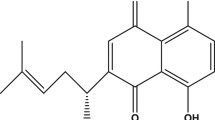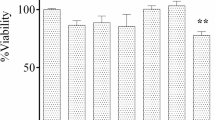Abstract
The health benefits of Mediterranean diet has long been reported and attributed to the consumption of virgin olive oil (VOO). Here, we evaluated the neuroprotective effect of VOO against Alzheimer’s disease by determining its effect on β-amyloid (Aβ)-induced cytotoxicity and oxidative stress, and explored the possibility that its hydroxycinnamic acids (Hc acids) content contribute significantly to this effect. SH-SY5Y cells treated with or without Aβ and with VOO or Hc acids (mixture of p-coumaric acid, ferulic acid, vanillic acid, and caffeic acid) were subjected to MTT assay and the results showed that both samples alleviated Aβ-induced cytotoxicity. Furthermore, both VOO and Hc acids decreased the reactive oxygen species level. Using western blot to determine the effect of these samples on Aβ-induced activation of pERK1/2, p38, and JNK MAPKs, results revealed that both VOO and Hc acids inhibited the activation of pERK1/2 and p-p38 MAPK, but not JNK. Moreover, VOO upregulated the glycolytic enzymes genes hexokinase (HK1), and phosphofructokinase (PFKM) expression which means that VOO enhanced the energy metabolism of the neurotypic cells, and therefore suggests another mechanism by which VOO could provide protection against Aβ-induced cytotoxicity. The findings in this study suggest that VOO has a neuroprotective effect, attributable to its hydroxycinnamic acids component, against Aβ-induced cytotoxicity and oxidative stress through the inhibition of the activation of MAPKs ERK and p38 and by enhancing the energy metabolism of the neurotypic cells.






Similar content being viewed by others
References
Aparicio R, Luna G (2002) Characterisation of monovarietal virgin olive oils. Eur J Lipid Sci Technol 104:614–627
Bartzoki G (2011) Alzheimer’s disease as homeostatic response to age-related myelin breakdown. Neurobiol Aging 32:1341–1372. doi:10.1016/j.neurobiolaging.2009.08.007
Betteridge JD (2000) What is oxidative stress? Metabolism 49:3–8. doi:10.1016/S0026-0495(00)80077-3
Birben E, Sahiner U, Sackesen C, Erzurum S, Kalayci D (2012) Oxidative stress and antioxidant defense. WAO J 5:9–19
Bourne LC, Rice-Evans CA (1998) Urinary detection of hydroxycinnamates and flavonoids in humans after high dietary intake of fruit. Free Radic Res 28:429–438
Bragado P, Armesilla A, Silva A, Porras A (2007) Apoptosis by cisplatin requires p53-mediated p38α activation through ROS generation. Apoptosis 12:1733–1742. doi:10.1007/s10495-007-0082-8
Brookmeyer R, Johnson E, Ziegler-Graham K, Arrighi HM (2007) Forecasting the global burden of Alzheimer’s disease. Alzheimer’s Dement 3:186–191. doi:10.1016/j.jalz.2007.04.381
Butterfield DA (2002) Amyloid β-peptide (1-42)-induced oxidative stress and neurotoxicity: implications for neurodegeneration in Alzheimer’s disease brain. Free Radic Res 36:1307–1313. doi:10.1080/1071576021000049890
Butterfield DA, Drake J, Pocernich C, Castegna A (2001) Evidence of oxidative damage in Alzheimer’s disease brain: central role for amyloid beta-peptide. Trends Mol Med 7:548–554. doi:10.1016/S1471-4914(01)02173-6
Butterfield DA, Swomley AM, Sultana R (2013) Amyloid β-peptide (1–42)-induced oxidative stress in Alzheimer disease: importance in disease pathogenesis and progression. Antiox Redox Sign 19:823–835. doi:10.1089/ars.2012.5027
Chen J, Ho C (1997) Antioxidant activities of caffeic acid and its related hydroxycinnamic acid compounds. J Agric Food Chem 45:2374–2378. doi:10.1021/jf970055t
Chen Z, Zhong C (2013) Decoding Alzheimer’s disease from perturbed cerebral glucose metabolism: implications for diagnostic and therapeutic strategies. Prog Neurobiol 108:21–43. doi:10.1016/j.pneurobio.2013.06.004
Chen Z, Zhong C (2014) Oxidative stress in Alzheimer’s disease. Neurosci Bull 30:271–281. doi:10.1007/s12264-013-1423-y
Christen Y (2000) Oxidative stress and Alzheimer disease. Am J Clin Nutr 71:621s–629s
Cicerale S, Lucas L, Keast R (2010) Biological activities of phenolic compounds present in virgin olive oil. Int J Mol Sci 11:458–479. doi:10.3390/ijms11020458
Craft S, Newcomer J, Kanne S, Dagogo-Jack S, Cryer P, Sheline Y, Luby J, dagogo-Jack A, Anderson A (1996) Memory improvement following induced hyperinsulinemia in Alzheimer’s disease. Aging 17:123–130. doi:10.1016/0197-4580(95)02002-0
Cunnane S, Nugent S, Roy M, Courchesne-Loyer A, Croteau E, Tremblay S, Castellano A et al (2011) Brain fuel metabolism, aging, and Alzheimer’s disease. Nutrition 27:3–20. doi:10.1016/j.pneurobio.2013.06.004
Daniels WM, Hendricks J, Salie R, Taljaard JJ (2001) The role of MAP-kinase superfamily in beta-amyloid toxicity. Metab Brain Dis 16:175–185. doi:10.1023/A:1012541011123
D’Archivio M, Filesi C, Di Benedetto R, Gargiulo R, Giovannini C, Masella R (2007) Polyphenols, dietary sources and bioavailability. Annali dell’Istituto Superiori Sanita 43:348–361
Dimitrios B (2006) Sources of natural phenolic antioxidants. Trends Food Sci Technol 2006:505–512. doi:10.1016/j.tifs.2006.04.004
Finkel T, Holbrook N (2000) Oxidants, oxidative stress and the biology of ageing. Nature (London) 408:239–247. doi:10.1038/35041687
Florent-Bechard S, Malaplate-Armand C, Koziel V, Kriem B, Olivier JL, Pillot T, Oster T (2007) Towards a nutritional approach for prevention of Alzheimer’s disease: biochemical and cellular aspects. J Neurol Sci 262:27–36. doi:10.1016/j.jns.2007.06.046
Giovannini MG, Scali C, Prosperi C, Bellucci A, Vannucchi MG, Rosi S, Pepeu G, Casamenti F (2002) β-amyloid-induced inflammation and cholinergic hypofunction in the rat brain in vivo: involvement of the p38MAPK pathway. Neurobiol Dis 11:257–274. doi:10.1006/nbdi.2002.0538
Isoda H, Motojima H, Margout D, Neves M, Han J, Nakajima M, Larroque M (2012) Antiallergic effect of Picholine olive oil-in-water emulsion through β-hexosaminidase release inhibition and characterization of their physicochemical properties. J Agric Food Chem 60:7851–7858. doi:10.1021/jf3016078
Kapogiannis D, Mattson MP (2011) Disrupted energy metabolism and neuronal circuit dysfunction in cognitive impairment and Alzheimer’s disease. Lancet Neurol 10:187–198. doi:10.1016/S1474-4422(10)70277-5
Lardeau A, Poquet L (2013) Phenolic metabolites derived from coffee consumption are unlikely to cross the blood–brain barrier. J Pharma Biomed Anal 766:134–138. doi:10.1016/j.jpba.2012.12.016
Lin MT, Beal MF (2006) Mitochondrial dysfunction and oxidative stress in neurodegenerative diseases. Nature (London) 443:787–795. doi:10.1038/nature05292
Manach C, Williamson G, Morand C, Scalbert A, Remesy C (2005) Bioavailability and bioefficacy of polyphenols in humans. I. Review of 97 bioavailability studies. Am J Clin Nutr 81:230S–242S
Miyamae Y, Han J, Sasaki K, Terakawa M, Isoda H (2011) 3,4,5-tri-Ο-caffeoylquinic acid inhibits amyloid β-mediated cellular toxicity on SH-SY5Y cells through the upregulation of PGAM1 and G3PDH. Cytotechnology 63:191–200. doi:10.1007/s10616-011-9341-1
Nciri R, Desmoulin F, Saleh Allagui M, El Feki A, Vincent C, Croute F (2013) Neuroprotective effect of chronic exposure of SH-SY5Y to low lithium concentration involve glycolysis stimulation, extracellular pyruvate accumulation and resistance to oxidative stress. Int J Neuropsychopharmacol 16:365–376. doi:10.1017/S1461145712000132
Nieves Franco M, Galeano-Diaz T, Lopez O, Fernandez-Bolanos JG, Sanchez J, De Miguel C, Victoria Gil M, Martin-Vertedor D (2014) Phenolic compounds and antioxidant capacity of virgin olive oil. Food Chem 163:289–298. doi:10.1016/j.foodchem.2014.04.091
Nizzari M, Venezia V, Repetto E, Caorsi V, Magrassi R, Gagliani MC, Carlo P, Florio T, Schettini G, Tacchetti C, Russo T, Diaspro A, Russo C (2007) Amyloid precursor protein and presenilin1 interact with the adaptor GRB2 and modulate ERK1,2 signaling. J Biol Chem 282:13833–13844. doi:10.1074/jbc.M610146200
Norton S, Matthews FE, Barnes DE, Yaffe K, Brayne C (2014) Potential for primary prevention of Alzheimer’s disease: an analysis of population-based data. Lancet Neurol 13:788–794. doi:10.1016/S1474-4422(14)70136-X
Ollivier D, Artaud J, Pinatel C, Durbec JP, Guerere M (2003) Triacylglycerol and fatty acid compositions of French virgin olive oils. Characterization by chemometrics. J Agric Food Chem 51:5723–5731. doi:10.1021/jf034365p
Owen RW, Giacosa A, Hull WE, Haubner R, Spiegelhalder B, Bartsch H (2000) The antioxidant/anticancer potential of phenolic compounds isolated from olive oil. Eur J Cancer 36:1235–1247. doi:10.1016/S0959-8049(00)00103-9
Perez-Lopez FR, Chedraui P, Haya J, Cuadros JL (2009) Effects of the Mediterranean diet on longevity and age-related morbid conditions. Maturitas 64:67–79. doi:10.1016/j.maturitas.2009.07.013
Sasaki K, Han J, Shimozono H, Villareal MO, Isoda H (2013) Caffeoylquinic acid-rich purple sweet potato extract, with or without anthocyanin, imparts neuroprotection and contributes to the improvement of spatial learning and memory of SAMP8 Mouse. J Agric Food Chem 61:5037–5045. doi:10.1021/jf3041484
Scarmeas N, Stern Y, Tang MX, Mayeux R, Luchsinger JA (2006) Mediterranean diet and risk for Alzheimer’s disease. Ann Neurol 59:912–921. doi:10.1002/ana.20854
Schroeter H, Spencer JPE, Rice-Evans C, Williams RJ (2001) Flavonoids protect neurons from oxidized low-density lipoprotein-induced apoptosis involving JNK, c-jun and caspase-3. Biochem J 358:547–557. doi:10.1042/bj3580547
Stadtman ER (2001) Protein oxidation in aging and age-related diseases. Ann N Y Acad Sci 928:22–38. doi:10.1111/j.1749-6632.2001.tb05632.x
Tamagno E, Robino G, Obbili A, Bardini P, Aragno M, Parola M, Danni O (2003) H2O2 and 4-hydroxynonenal mediate amyloid β-induced neuronal apoptosis by activating jnks and p38mapk. Exp Neurol 180:144–155. doi:10.1016/S0014-4886(02)00059-6
Van Merloo J, Kaspers GJL, Cloos J (2011) Cell sensitivity assays: the MTT assay. Methods Mol Biol 731:237–245. doi:10.1007/978-1-61779-080-5_20
Vlassenko AG, Raichle ME (2014) Brain aerobic glycolysis functions and Alzheimer’s disease. Clin Transl Imaging 3:27–37. doi:10.1007/s40336-014-0094-7
Wang X, Wang W, Li L, Perry G, Lee H, Zhu X (2014) Oxidative stress and mitochondrial dysfunction in Alzheimer’s disease. Biochim Biophys Acta 1842:1240–1247. doi:10.1016/j.bbadis.2013.10.015
Zhang J, Melton LD (2008) Cytoprotective effects of polyphenolics on H2O2-induced cell death in SH-SY5Y cells in relation to their antioxidant activities. Eur Food Res Technol 228:123–131. doi:10.1007/s00217-008-0915-x
Zhang L, Hongsheng W, Wang T, Jiang N, Yu P, Chong Y, Fu F (2014) Ferulic acid ameliorates nerve injury induced by cerebral ischemia in rats. Exp Ther Med 9:972–976. doi:10.3892/etm.2014.2157
Zhou F, Xu Y, Hou XY (2014) MLK3-MKK3/6-P38MAPK cascades following N-methyl-d-aspartate receptor activation contributes to amyloid-β peptide-induced apoptosis in SH-SY5Y cells. J Neurosci Res 92:808–817. doi:10.1002/jnr.23354
Author information
Authors and Affiliations
Corresponding author
Ethics declarations
Conflict of interest
The authors declare no conflict of interests.
Rights and permissions
About this article
Cite this article
Villareal, M.O., Sasaki, K., Margout, D. et al. Neuroprotective effect of Picholine virgin olive oil and its hydroxycinnamic acids component against β-amyloid-induced toxicity in SH-SY5Y neurotypic cells. Cytotechnology 68, 2567–2578 (2016). https://doi.org/10.1007/s10616-016-9980-3
Received:
Accepted:
Published:
Issue Date:
DOI: https://doi.org/10.1007/s10616-016-9980-3




